#Women in World War II
Text
"She lied to a military police officer down by a hospital ship, said she was going to interview nurses about the 'woman’s angle,' and they let her on, because, as she said, no one gave a hoot about the woman’s angle. It served as the perfect forged passport for her," said Somerville. She resorted to those measures because her husband, Ernest Hemingway, tried to take over her journalist career.
This Saturday, June 6, will be the 76th anniversary of D-Day, the battle that would come to represent the beginning of the end of World War II.
There was just one woman, a war correspondent, on the beaches at Normandy that day the allied forces liberated Western Europe from Nazi Germany: the singular Martha Gellhorn. Author Janet Somerville traces Gellhorn’s extraordinary life in her book Yours, For Probably Always: Martha Gellhorn’s Letters of Love and War.
"Since 1937, Martha had been a war correspondent for Collier’s magazine. She knew about the Allied invasion, that there was a plan to cover the Allied invasion of Normandy, and she was determined to cover that," Somerville said.
The problem was, her very famous husband at the time, Ernest Hemingway, pulled the rug out from under her professionally.
"Hemingway had gone to New York, introduced himself to her editor at Collier’s and said ‘I’ll be your war correspondent.’ And he took her accreditation papers. Which was a bit of a problem," said Somerville.
Each publication could send just one correspondent. But Gellhorn was resourceful and clever. She found herself passage on a munitions ship from New York that would get her to Europe. She was the only woman and the only civilian aboard that ship, which landed in Liverpool. Then, she just needed to get to Normandy.
"She lied to a military police officer down by a hospital ship, said she was going to interview nurses about the 'woman’s angle,' and they let her on, because, as she said, no one gave a hoot about the woman’s angle. It served as the perfect forged passport for her," said Somerville.
Once on board the hospital ship, Gellhorn locked herself into a bathroom until they sailed. When the ship docked in Normandy, she waded ashore through waist-deep water with some of the medical officers.
"She became the only woman and the only war correspondent to be actually on the beaches at Normandy, evacuating the wounded."
Though she was there as a journalist to write about the event, she couldn’t help but tend to the wounded soldiers. She had an uncanny ability, Somerville says, to focus on what needed to be done. So when she saw that the wounded were hungry and thirsty, she set to work.
"She just took it in her stride and found somebody who could bring teapots to tip into their mouths,if they couldn't hold a glass. She just took charge and made sure that they got something," Somerville said.
She also managed to be one of many correspondents who wrote about D Day.
"The incredible thing about D-Day is that accredited correspondents produced 700,000 words of text, just about D-Day," Somerville said. "Martha was one of them. She had a piece called 'Over and Back' that Collier’s published."
Gellhorn went on to report into her old age, from all corners of the globe. She filed her last piece, about the murdered street children of Salvador, Brazil, more than 50 years after D-Day, when she was 87 years old.
Yours, For Probably Always: Martha Gellhorn’s Letters of Love and War, 1930-1949 by Janet Somerville is available at the link above, or wherever you buy your books.
#Women in history#Women in World War II#D-Day#women in journalism#Martha Gellhorn#janet Somerville#Yours#For Probably Always: Martha Gellhorn’s Letters of Love and War#Books by women#books about women#Fuck Ernest Hemingway
606 notes
·
View notes
Text

Red Cross “Clubmobile Girl” Katherine Spaatz with American servicemen
120 notes
·
View notes
Text
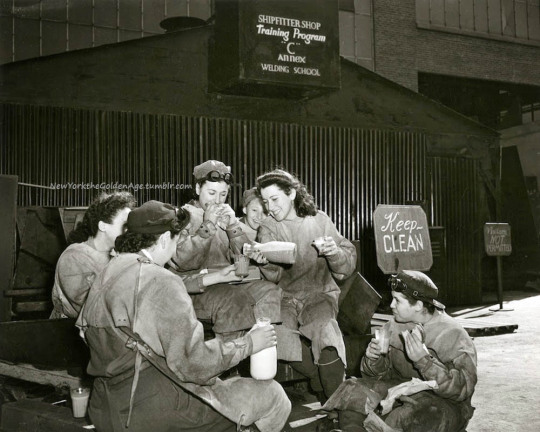
Female shipfitters on a lunch break at the Brooklyn Navy Yard, August 1944.
Photo: U.S. Navy/NY Historical Society/Vintage Everyday
#vintage New York#1940s#World War II#home front#women in World War II#shipfitters#Brooklyn Navy Yard#women in men's roles#vintage Brooklyn#vintage NYC
308 notes
·
View notes
Link
“In 1919 after the outbreak of the Polish-Soviet war Wanda ‘Kazik’ Gertz became the commander of the 2nd Women’s Volunteer Legion in the Polish army. The legion fought for Vilnius which led to Gertz being awarded the rank of lieutenant as well as the Virtuti Militari medal. She couldn’t enjoy her position for too long though, as in 1922 she lost her lieutenant rank due to the lack of law stating that a woman can be an officer in the Polish army. Afterwards, ‘Kazik’ worked in different fields for 17 years – she worked in an engineering company, in Józef Piłsudski’s office, in the management team of the Belweder Museum etc.
In World War II Gertz created a pseudonym for herself: ‘Lena’, and became one of the first women to join the resistance movement Service for Poland’s Victory. Soon after that, she made history as the first woman to create and command a fully female military unit – ‘DYSK’ unit (Women’s Diversion and Sabotage Unit) as a part of the Polish Home Army. In 1944 she was promoted to the rank of major.”
#history#women in history#wanda gertz#poland#polish history#first world war#second world war#Women in World War II#women in war#20th century#warriors#women's history#female soldiers
17 notes
·
View notes
Text

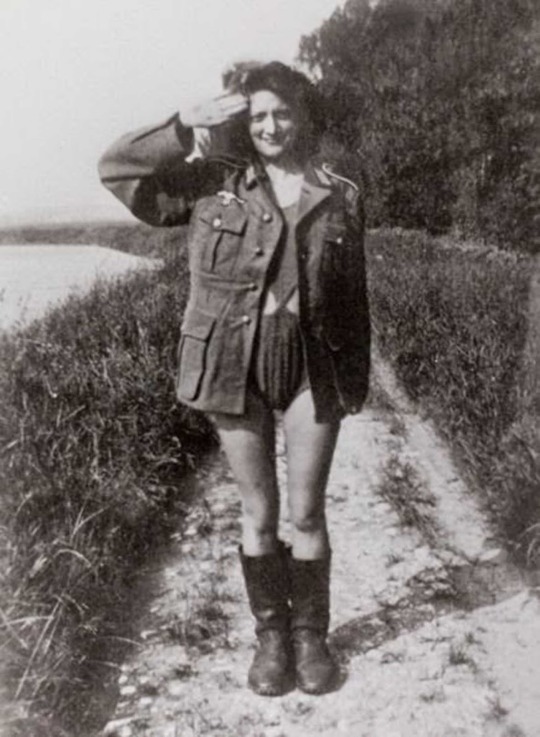
French girls wearing their German boyfriends uniforms during World War 2. The photo on the right was found on a German POW.
#historical photos#history#historical#ww2#world war 2#world war ii#second world war#ww2 photos#wwii#wwii photos#ww2 history#wwii history#1940s#1940s women#1940s photos#ww2 women
417 notes
·
View notes
Text

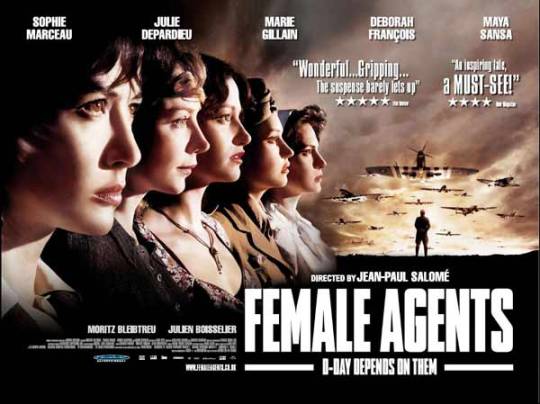
Women in World War II: The Spies They Never Saw Coming
Left to right, Noor Inayat Khan (Imperial War Museums), Josephine Baker (Library of Congress), and Virginia Hall (Lorna Catling Collection).
Josephine Baker, an American vaudeville performer turned glittering star of Paris, was at the peak of her fame in 1939 when the Nazi regime began its stranglehold on Europe. But then came an offer that changed her life.
Like Baker, Virginia Hall, an American who lost a leg in a hunting accident, and Noor Inayat Khan, a Muslim pacifist, weren’t prototypical spies. And that was exactly the point. Learn how they turned prejudice and society’s low expectations of women into weapons that hid their critical work to defeat the Nazis.
Speakers
CIA Museum's Deputy Director
Dr. Elizabeth Baer, Holocaust Studies expert and research professor, Gustavus Adolphus College, St. Peter, Minnesota
Moderator
Dr. Edna Friedberg, Historian, United States Holocaust Memorial Museum
Watch live at facebook.com/holocaustmuseum. You do not need a Facebook account to view our program. After the live broadcast, the recording will be available to watch on demand on the Museum's Facebook page
📖 https://www.ushmm.org/online-calendar/event/vefbswmnspies0321

📖 Related 📖
Marisa Diena: Spy Trainer Partisan spy Marisa Diena and other Italian women partisans were able to move about during the day without arousing suspicion, unlike their male counterparts, most of whom were army deserters. She enlisted and trained other women to become spies and couriers. Learn More https://encyclopedia.ushmm.org/content/en/article/marisa-diena
📖
The Double Life of Josephine Baker We remember Josephine Baker as a singer and dancer who had to leave her native country to find freedom and fame. What fewer know is that when Nazism threatened that freedom she so treasured, Baker also turned her talents toward defending it—as a spy. Learn More - https://medium.com/memory-action/the-double-life-of-josephine-baker-ad35134af8dd
📖
Faye Schulman: Secret Photographer After her family was killed in a massacre in occupied Poland, Faye Schulman, spared for her photographic abilities, fled and joined a partisan group. She took over 100 photos, documenting a rare side of partisan activity. Learn More https://encyclopedia.ushmm.org/content/en/article/faye-schulman

0 notes
Text
The WAVES of Change: Women's Valiant Service in World War II 🌊
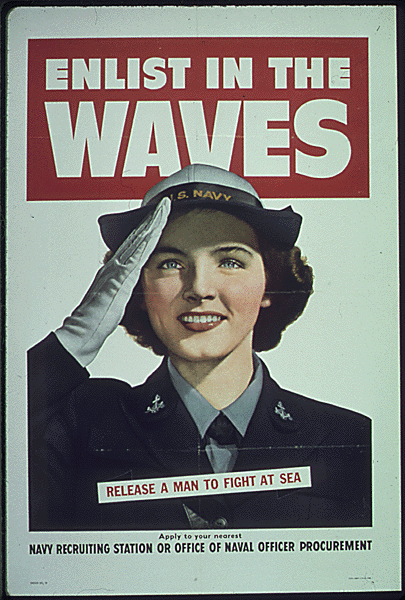
When the tides of World War II swelled, an unprecedented wave of women stepped forward to serve their country, becoming an integral part of the U.S. Navy through the Women Accepted for Volunteer Emergency Service (WAVES) program. This initiative not only marked a pivotal moment in military history but also set the stage for the transformation of women's roles in the armed forces and society at large. The WAVES program, initiated in 1942, was a beacon of change, showcasing the strength, skill, and patriotism of American women during a time of global turmoil.
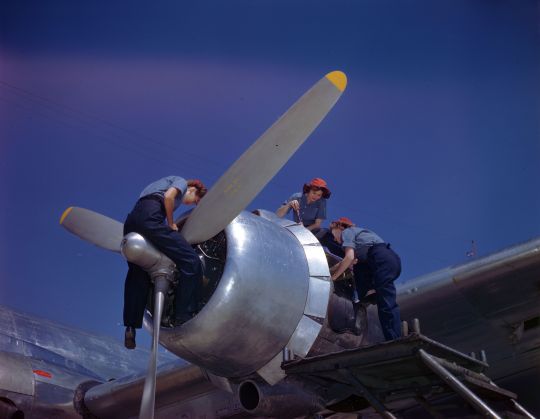
The inception of WAVES was a response to the urgent need for additional military personnel during World War II. With many American men deployed overseas, the United States faced a shortage of skilled workers to support naval operations on the home front. The WAVES program was spearheaded by figures such as Lieutenant Commander Mildred H. McAfee, the first woman commissioned as an officer in the U.S. Navy. Under her leadership, WAVES members were trained in various specialties, including communications, intelligence, supply, medicine, and logistics, proving that women could perform with as much competence and dedication as their male counterparts.
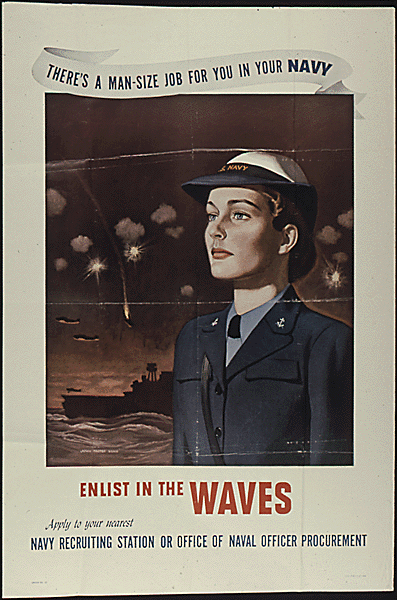
The impact of the WAVES program extended far beyond the war effort. Throughout their service, WAVES members faced and overcame significant societal and institutional challenges. At the time, the idea of women serving in the military was met with skepticism and resistance; however, the exemplary service of the WAVES shattered stereotypes and demonstrated the invaluable contributions women could make in traditionally male-dominated fields. Their work during the war not only contributed significantly to the Allies' victory but also laid the groundwork for the integration of women into the regular armed forces.

The legacy of the WAVES program is a testament to the courage and determination of the women who served. Their contributions went largely unrecognized for many years, but the program's impact on military and gender norms has been profound. The WAVES paved the way for future generations of women in the military, demonstrating that service and sacrifice know no gender. Today, women serve in all branches of the U.S. military, in roles ranging from combat positions to high-ranking officers, thanks in no small part to the trail blazed by the WAVES.


The WAVES program was more than just a wartime necessity; it was a watershed moment in the history of women's rights and military service. The women of WAVES not only supported the United States during a critical period but also propelled forward the conversation about gender equality in the armed forces and beyond. Their legacy is a reminder of the strength and resilience of women who rise to the challenge, breaking barriers and making waves in pursuit of a better world.
Read more: https://prologue.blogs.archives.gov/2023/11/06/historic-staff-spotlight-eunice-whyte-navy-veteran-of-both-world-wars/
201 notes
·
View notes
Text
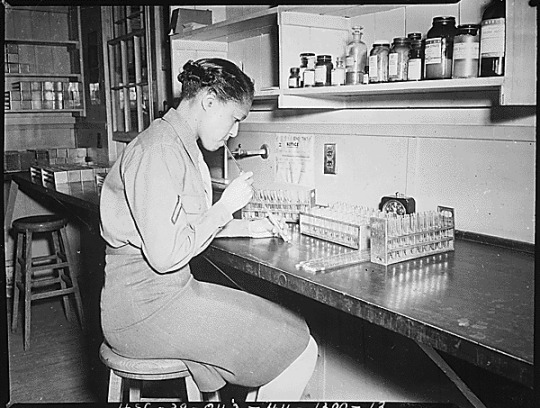
"Pfc. Johnnie Mae Welton, Negro WAC, laboratory technician trainee, conducts an experiment in the serology laboratory sf the Fort Jackson Station Hospital, Fort Jackson, SC."
Record Group 111: Records of the Office of the Chief Signal OfficerSeries: Photographs of American Military Activities
This black and white photograph shows Pfc. Johnnie Mae Walton, an African American woman in the Women’s Army Corp, sitting at a lab table. She wears a military uniform and her hair is tied back. She appears to be blowing through a straw into a test tube. Three racks of test tubes are on the lab table before her.
131 notes
·
View notes
Text
A Woman’s War
Personnel shortages led the military to enlist more than 300,000 women volunteers during World War II. All of the military services created posters that encouraged women to join up. Thousands were recruited to serve as nurses. But many more chose to enter one of the women’s auxiliaries formed by the services.
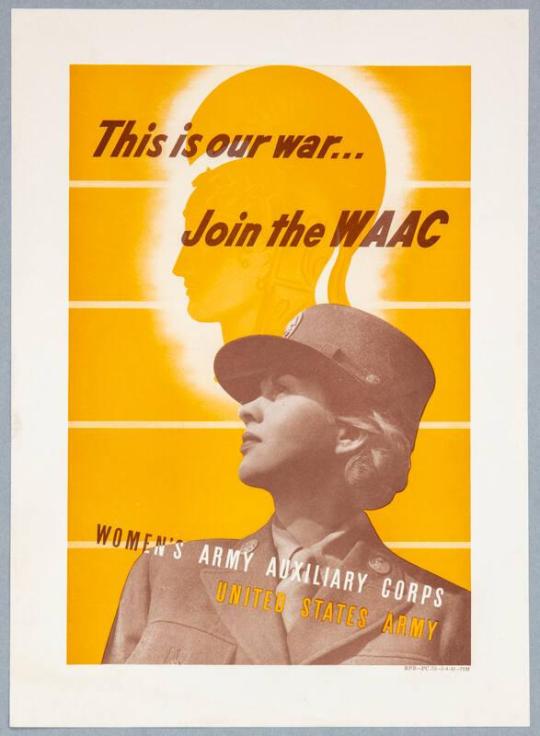
Over 150,000 served in the Women’s Army Corps (WAC/WAAC) in jobs ranging from telephone, radio, and teletype operator to cryptographer, medical technician, sheet metal worker, and aircraft mechanic.
The Navy recruited over 80,000 WAVES (Women Accepted for Volunteer Emergency Service). They worked as clerks, secretaries, cryptologists, air traffic controllers, meteorologists, and translators.

The Marine Corps Women’s Reserve, established in February 1943, enrolled 23,000 women during the war.
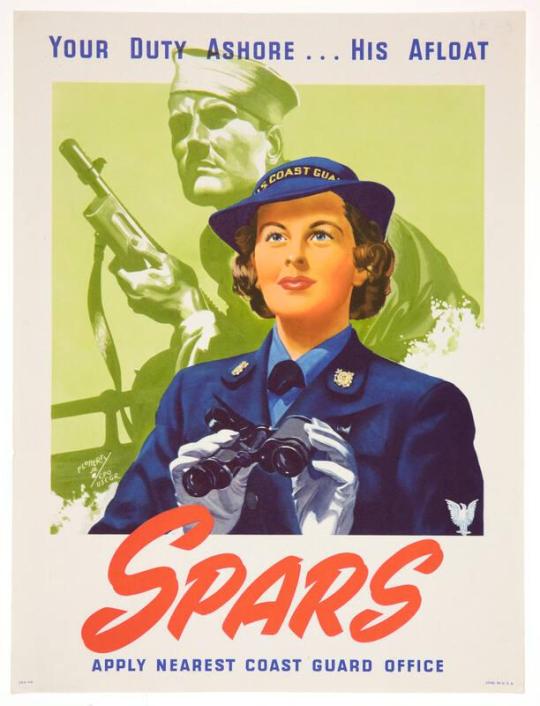
While the Coast Guard Women’s Reserve enlisted more than 10,000 between 1942 and 1946.
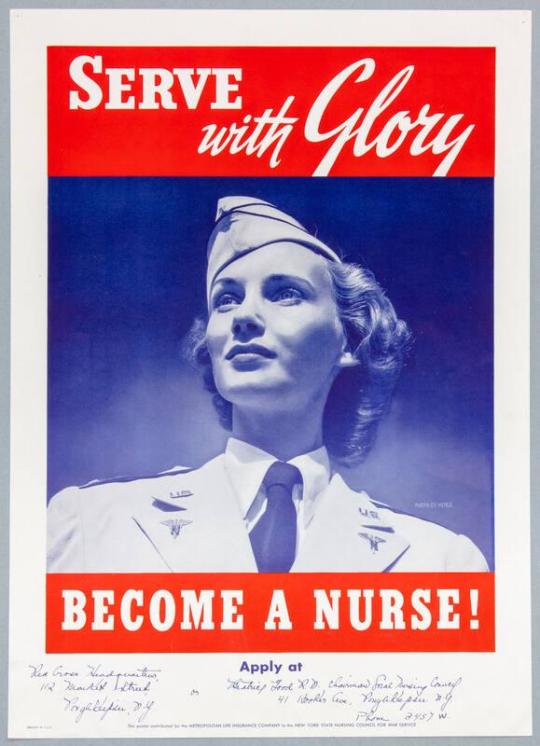
Like some of the wartime posters that encouraged women to the join the industrial workforce, military recruitment posters sometimes offered mixed messages. Prevailing biases regarding gender roles dictated that women not serve in combat roles.
Learn more about this collection: https://fdr.artifacts.archives.gov/advancedsearch/Objects/invno%3AMO%202005.13.17*/images?page=1
Follow along throughout 2024 as we feature more #TheArtOfWar WWII posters from our Digital Artifact Collection.
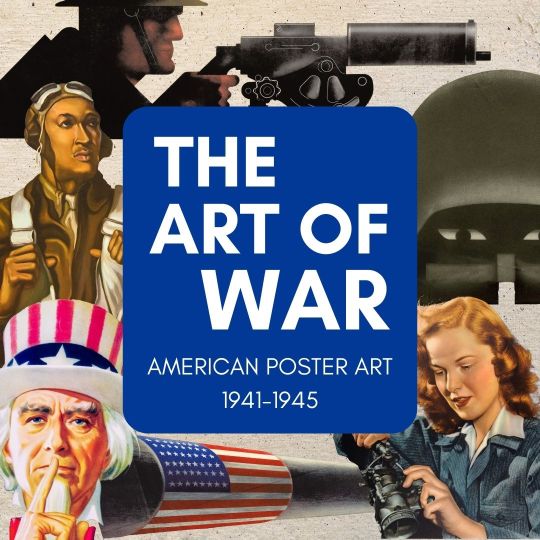
101 notes
·
View notes
Text

"During the tension of World War II, a revue has dressed one of their showgirls in a gas mask and helmet in addition to a sexy outfit."
Anonymous photographer, September 1939, England.
#1930s#old photos#women#*#30s#world war ii#b&w#black and white#showgirls#gas mask#photography#vintage#history#show girl#vintage style#vintage fashion#world war 2#wwii#ww2#world war two#30s style#1930s style#30s fashion#black and white photography#b&w photography#dance#dancer
137 notes
·
View notes
Text

Citation: WACs performed 155 roles during WWII.
I found this while doing some research for my MotA OFC.
74 notes
·
View notes
Text

LIBERTY, February 19, 1944




68 notes
·
View notes
Note
Came across this via Facebook and thought you'd like it. 😉
.
Four female pilots leaving their plane, ‘Pistol Packin' Mama’, at the four engine school at Lockbourne AAF. They are members of a group of Women Airforce Service Pilots who have been trained to ferry the B-17 Flying Fortresses. World War II, 1944.

Ummm yeasss, thank you, gimme gimme 💋
15 notes
·
View notes
Text
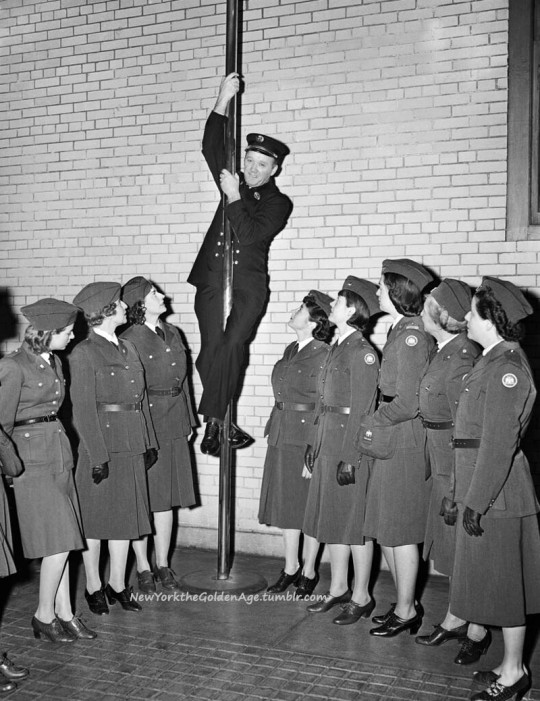
Lieut. James A. Hoey of Hook and Ladder Company No. 2 demonstrates the art of sliding down a firehouse pole to some of the female volunteers studying measures of air raid protection on December 16, 1941.

Then Jean Kelly volunteered to take a turn.
Photos: Charles Kenneth Lucas for the AP
#vintage New York#1940s#Charles Kenneth Lucas#World War II#home front#women at war#air raid drill#Dec. 16#16 Dec.#women in World War II
70 notes
·
View notes
Text
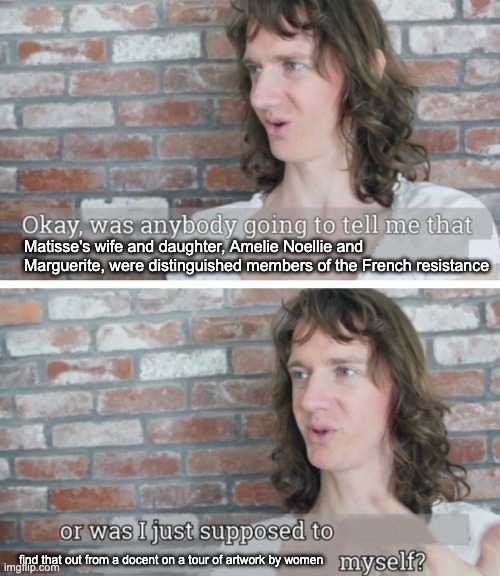
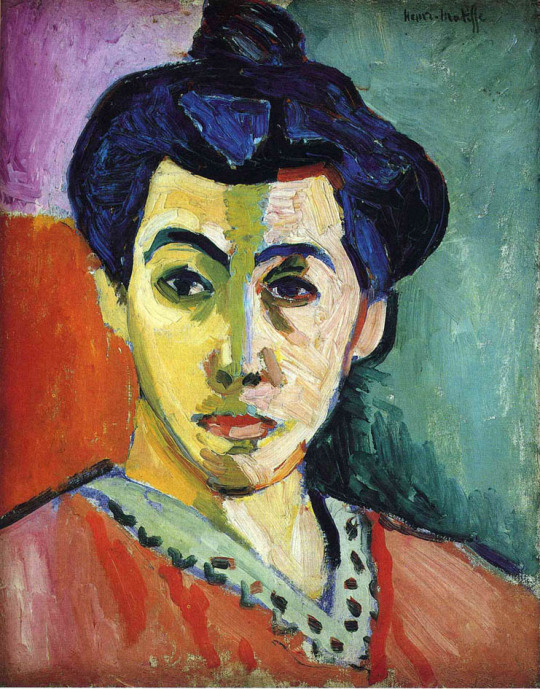

#marguerite matisse#henri matisse#amelie noellie matisse#ww2#french resistance#world war 2#world war ii#wwii#women in art#women in history#post#gayle meme#gayle waters waters meme#chris fleming#gayle waters waters#was anyone going to tell me#or was i just supposed to#20th century#history memes
86 notes
·
View notes
Text
Tosia Altman

Tosia Altman was born in 1919 in Lipno, Poland. Altman was an active member of the resistance in Nazi-occupied Poland. A member of Ha-Shomer ha-Za’ir, a Jewish youth movement, she traveled around Poland to organize the movement's members, even though Jews were not allowed to travel by train. Altman smuggled weapons into the Warsaw and Krakow Ghettos. During the Warsaw Uprising in 1943, she helped pass on information within the ghetto and to the outside world, and helped smuggle Jews out of the ghetto. She was injured in a fire and handed over to the Germans. She died in custody in 1943, at the age of 23.
42 notes
·
View notes